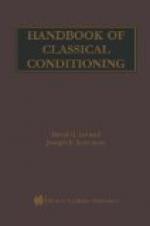|
This section contains 2,361 words (approx. 8 pages at 300 words per page) |

|
Classical conditioning involves learning the relations between stimuli. In its simplest form, a neutral stimulus precedes a stimulus (the unconditioned stimulus, or US) that elicits a response (the unconditioned response, or UR). Learning is indexed by the development of a response (the conditioned response, or CR) to the neutral stimulus (which is now a conditioned stimulus, or CS). The interval between the onset of the CS and the onset of the US is called the interstimulus interval (ISI). Stimuli that can become CSs may be discrete or more contextual, and they need not even be external (Bouton, Mineka, and Barlow, 2001). Responses to stimuli (both CRs and URs) may be as simple as an eye blink or more complex, such as approach and withdrawal. Originally thought to be due simply to contiguity between the CS and US, modern conceptions of learning in classical...
|
This section contains 2,361 words (approx. 8 pages at 300 words per page) |

|


